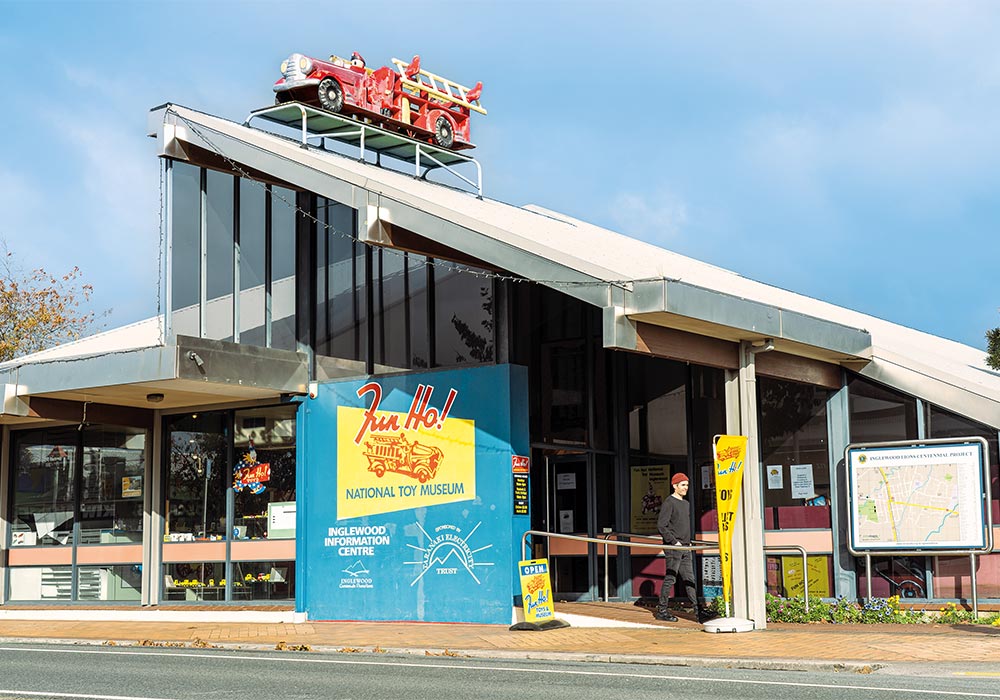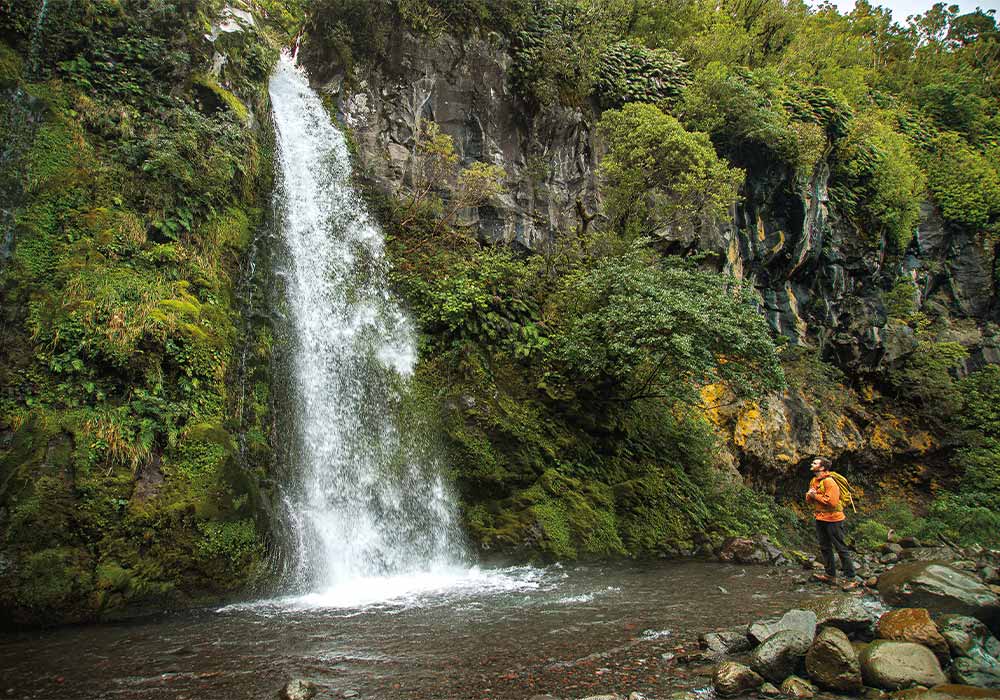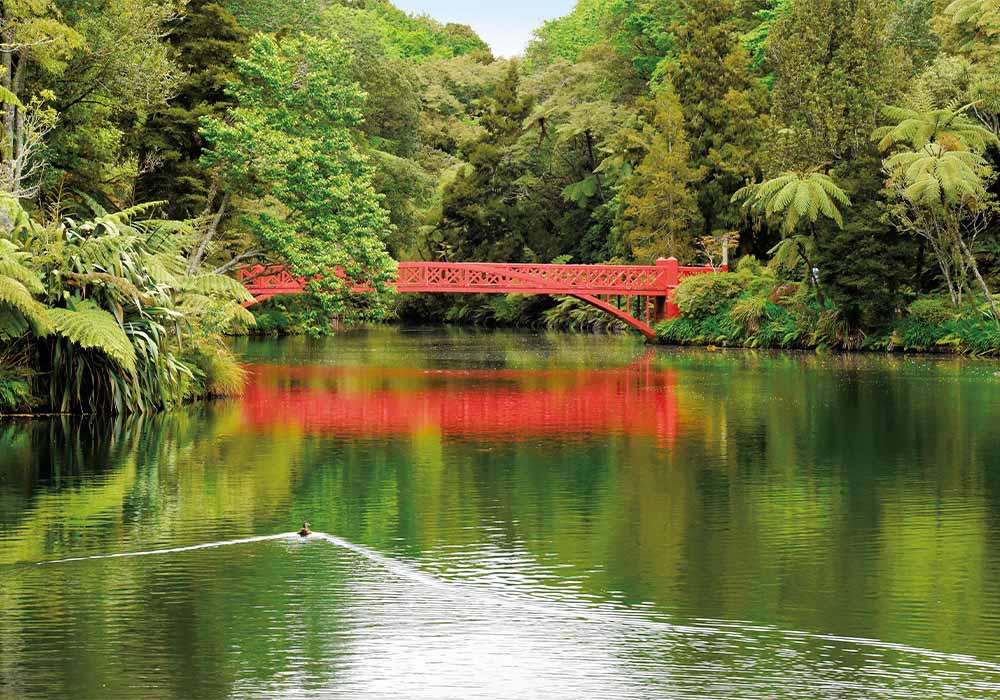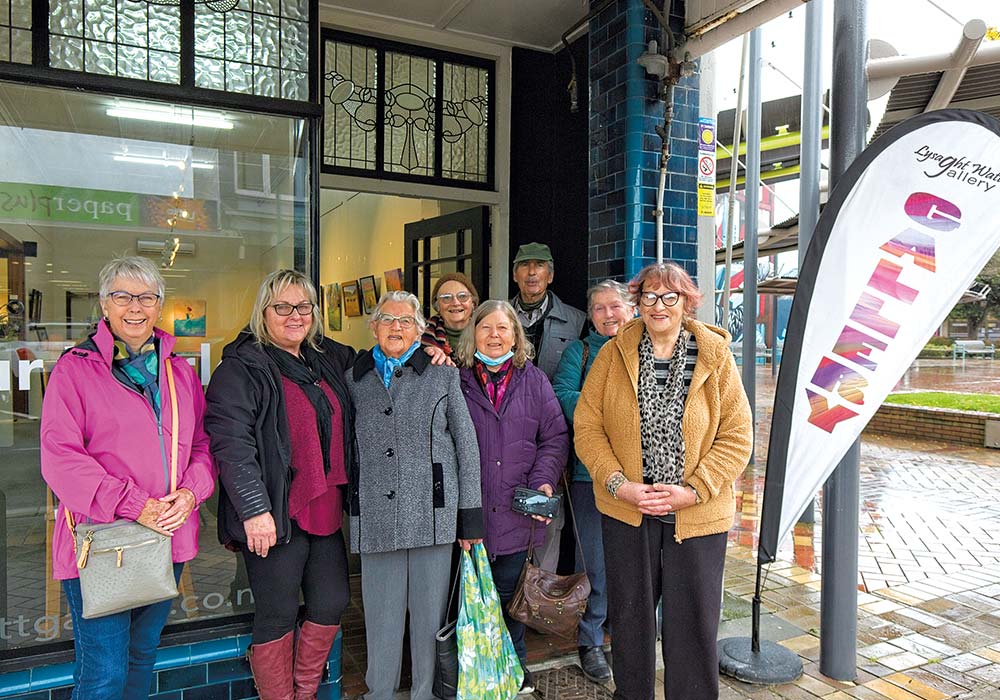Wendy Montrose is a regular visitor to Taranaki but still manages to discover new delights every time she returns
This recent visit was my retirement trip and the last one in our little slide-on camper before we sold it, so I got to choose where to go and what to do. Taranaki is always a favourite, so it wasn’t a hard decision.
The birthplace of Peter Snell, a number of legendary All Blacks, and my Mum, it feels familiar, yet every time I visit, I discover something new. This time, I was determined to soak up the arts scene, in particular, and drag Ross, my trusty sidekick along for the ride.
Taranaki lives up to its slogan (Taranaki Like No Other) in every way and really is quite unique. It’s almost a condensed version of all the best things about New Zealand, with glorious forests, surf beaches, and that iconic mountain all within easy reach. And don’t let anyone tell you it rains too much. The region is consistently one of the sunniest in New Zealand, with New Plymouth taking out first place in the North Island last year.
Shakespeare’s Stratford

After an adventure on the Forgotten World Highway, we rolled into Stratford (formerly Stratford-upon-Pātea, did you know?) just in time to watch the glockenspiel perform. Housed in the clock tower in the centre of Stratford, it’s the only one of its kind in New Zealand. Like a xylophone with metal keys, the glockenspiel plays for around five minutes four times a day and is accompanied by scenes from Shakespeare’s Romeo and Juliet, acted out by wooden figures in the windows. The last time I’d seen it was years ago with 50 12-year-olds in pouring rain, so this was a rare treat with only a wee crowd to watch the performance.
Shakespeare is a theme here in Stratford in case you hadn’t noticed. Sixty-seven streets bear the names of Shakespeare characters, and a short walk from the town centre down Regan Street at King Edward Park, you’ll find a Shakespeare mural painted by local artist Elyse Lewis.
Clouds started rolling in and as the first spits of rain fell, we ducked into the Percy Thomson Art Gallery. Recognised as Taranaki’s best public regional art gallery, the Percy Thomson is world-class with exhibitions by artists from Taranaki and all over Aotearoa. With new exhibitions starting every three to six weeks, it’s worth a visit every time you’re in the region. In March, they’ll be showing Gathered Voices: Highlights from the Fletcher Trust Collection, a must-see exhibition in my opinion.
Egmont National Park

We love to get close to nature and with seven freedom camping spots, Egmont National Park beckoned. There are sites available for self-contained vehicles at both the North Egmont and Dawson Falls visitor centres, and DOC offers a range of walks, from a 10-minute stroll to a four-day tramp. At Dawson Falls, although the weather wasn’t great, we still managed to stretch our legs on the Kapuni Loop Track through the mountain rainforest to the picturesque Dawson Falls. It was an easy one-hour track and a good way to warm up. We chose North Egmont last time and spent the night buffeted by wind in hail and sleet only to wake to a fine day with a splendid view of the Maunga’s dusting of fresh snow.
Intriguing Inglewood

Back on the main road, we passed through the small town of Inglewood. In 1875, the Provincial Council chairman dashed a bottle of champagne against a tree trunk and officially named the tiny settlement around him Inglewood. Today, SH3 passes through the town on its way to New Plymouth.
Ross spotted the fire engine on the roof of the Fun Ho! National Toy Museum in the centre of town and there was no way he would drive past. The museum displays more than 3000 toys cast from lead, aluminium, and zinc alloy by local business Underwood Engineering Co. between 1935 and 1982. In the 1970s, over a million Fun Ho! toys were sold each year, so it’s likely you had one as a child. Richard Jordan still makes toys on-site, and if the furnace is fired up, you’re welcome to watch him in action. The museum also houses a theaterette, a slot car track, and a sand pit where you can let loose with the toys from your childhood.
We stopped at Lake Mangamahoe on the way to New Plymouth, the site of Taranaki’s premier mountain bike park where you can puddle around on a family track or get serious and airborne on a Grade 6. Afterwards, it’s a treat to cool off with a dip in the lake under the watchful eye of Taranaki Maunga.
Naturally New Plymouth

Like a migrating bird, I can’t help homing into Mum’s hometown. Even though I’ve never lived there, New Plymouth has a special place in my heart. From the Coastal Walkway to Pukekura Park and everywhere in between, this small city is vibrant and welcoming. With a population of only around 60,000, New Plymouth packs a lot of punch with a lively arts scene, classy distilleries and craft breweries, and excellent cafés and restaurants.
Puke Ariki, comprising a museum, library, research centre, and isite, and the stunningly unique Len Lye Centre offer top-notch experiences, and there are also a number of independent galleries and museums worthy of a visit.
One that was on my itinerary was Gover Street Gallery. The brainchild of artists Heidi and Mike Griffin, the gallery is run by volunteers and is open to everyone to exhibit their work. The large, bright space has a colourful mural on the outside and a stylish interior you need to see more than once to take it all in. To celebrate the gallery’s fifth birthday, Heidi has curated an eclectic mix of local artists to sit alongside the private collection of Ans Westra.
Another place I can’t go past is the Wild Pear Kitchen where I stock up on fresh, flavoursome salads and plant-based goodies. Even Ross, a committed carnivore, can’t resist when he can mix his own salad or try something from the cabinet topped off with locally roasted IncaFé Coffee. Owner and head chef Chere Bailey even makes the delicious cakes healthy.
There are plenty of opportunities for exercise in the city, and if you love a challenge – and I mean a challenge – scaling Paritutu Rock, a remnant of an ancient volcano, takes about 15 minutes, and I’m reliably informed that the top offers some of the best views of the New Plymouth coastline. The track up is a steep climb with loose footing and being a little wary of heights, I chose to stay firmly anchored on the flat. Good views of Tapuae Marine Reserve and the Sugar Loaf Islands can be gained from the car park.
Some of the country’s most stunning gardens grow in the shadow of Taranaki. Public spaces such as Pukekura Park and Pukeiti are the jewels in the region’s crown, but there are plenty of others, too. We stopped at Tūpare, a premier landscaped garden bearing the New Zealand Gardens Trust’s highest six-star rating. Owned and managed by the Taranaki Regional Council, Tūpare features a stunning Chapman-Taylor-designed house in the Arts & Crafts style and is a beautiful place to spend a few hours at any time of year.
Leaving New Plymouth on SH45, we passed through Ōakura before taking a side trip to Lucy’s Gully. The Kaitake Range behind the town is much warmer than most of Egmont National Park. Given its exposure to warm westerly air, the vegetation is different. You’ll find nikau palms and karaka trees and surprisingly, at Lucy’s, a stand of Californian redwood trees. Planted in the 1930s, they are protected by a special dispensation in the Egmont National Park Management Plan and share their spot with regenerating native forests. It’s a starting place for a couple of walking tracks and a unique place to have a picnic.
OMG Ōpunakē

A drive on the surf highway should be compulsory; you just never know what you’ll find.
A sign for the Historic Cape Light and Museum caught our attention on the way to Ōpunakē. This two-third height replica of the original Cape Egmont lighthouse houses the 1850’s Fresnel Prismatic Light that powered the Cape Egmont Light until 1999 as well as other artefacts and informative panels. The museum relies on donations so take some cash; it’s worth the detour.
I don’t know why I’ve never been to Ōpunakē before. It’s a delightful town of fewer than 1500 souls above a stunning black sand beach.
We found a space at the Ōpunakē Beach Holiday Park, a clean, friendly campground right beside the surf club in a prime spot for swimming or surfing. Once we were settled, we stretched our legs on the Ōpunakē Loop Trail and took in fabulous views of the lake and headlands before stopping in town for a pie at the Arty Tarts Cafe.
The locals are chatty and welcoming and not shy to give a bit of cheek. Pick the right day and you can take in a movie at the beautifully restored Everybody’s Theatre or catch a stunning sunset from one of the town’s mosaic couches.
How about Hāwera?

Our last stop before heading to Wellington was the small hamlet of Hawera where I wanted to visit the Lysaght Watt Gallery. Hāwera’s community art gallery next to the town square, presents curated exhibitions that change monthly. Showcasing a range of works in a wide variety of mediums, the gallery hosts exhibitions in collaboration with groups and institutions from around Taranaki and nationally. Exhibitions include pieces contributed by their own gallery members, local artists, and invited artists, as well as national touring exhibitions. Check out March’s offering, Face to Face: A Portrait Exhibition.
Being out on something of a geographical limb doesn’t mean Taranaki is a cultural backwater. On the contrary, its very location seems to have fuelled local creativity and ingenuity. And remember, there’s a whole lot more to see than New Plymouth itself with outlying areas most definitely worth some extra time and a wider look.






